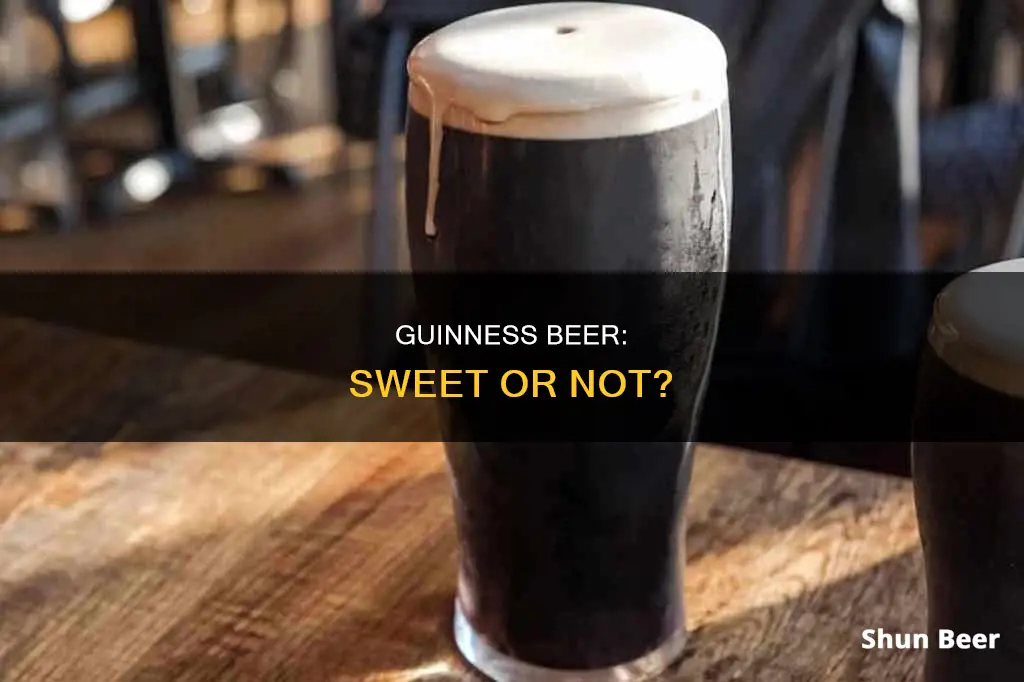
Guinness is a stout beer that originated in Dublin, Ireland, in the 18th century. It has a distinct dark colour and a unique taste that has made it one of the most successful alcohol brands worldwide. But is Guinness beer sweet? The answer lies in its complex flavour profile, which includes a malty sweetness balanced by a hoppy bitterness, with notes of coffee and chocolate. The roasted unmalted barley used in its brewing adds a distinctive roasted flavour, while the combination of nitrogen and carbon dioxide gives it a smooth, creamy texture.
| Characteristics | Values |
|---|---|
| Sweetness | Malty |
| Bitterness | Hoppy |
| Flavour notes | Coffee and chocolate |
| Roasted flavour | Yes, from roasted unmalted barley |
| Nose | Sweet, with hints of malt |
| Palate | Smooth, creamy, balanced, velvety |
What You'll Learn

Guinness is a stout with a malty sweetness and a hoppy bitterness
Guinness has a complex flavour profile, with notes of coffee and chocolate. It has a sweet nose, with hints of malt, and a smooth, creamy, balanced palate. The texture is velvety, and the finish is rich and distinctive. The combination of sweet and bitter flavours creates a bold and unique taste experience.
The nitrogen-infused widget technology used in canned Guinness contributes to its creamy head and smooth taste. This technology was first introduced in 1959 and changed the fundamental texture and flavour of the beer. Nitrogen bubbles are smaller than carbon dioxide bubbles, resulting in a creamier and smoother consistency.
Guinness has a long history dating back to the 18th century when Arthur Guinness started brewing ales at St. James's Gate Brewery in Dublin, Ireland. Over the years, Guinness has expanded its brewing operations globally and is now available in over 120 countries.
Guinness Beer: German or Irish?
You may want to see also

The beer is not black, but a very dark shade of ruby
The dark shade of ruby is also a result of the nitrogen bubbles in the beer, which are much smaller than CO2 bubbles. This change was implemented in 1959, and it altered the texture and flavour of the beer, giving it a "creamier" and "smoother" consistency. The nitrogen bubbles are created by forcing the draught beer through fine holes in a plate in the tap, which causes the characteristic "surge". This is also achieved by the widget in cans and bottles, a small plastic ball containing nitrogen.
The ruby red colour is also enhanced by the two-stage pouring process. The glass is tilted at a 45-degree angle and filled three-quarters full, then allowed to settle before being topped off. This process creates the quintessential creamy white head, which is caused by the nitrogen bubbles.
The ruby red colour of Guinness is so distinctive that it has inspired a range of merchandise, including a line of creative advertisements featuring a colourful toucan. The beer's unique appearance has also led to it being referred to as "the black stuff" in marketing campaigns.
Guinness Beer: A Natural Laxative?
You may want to see also

Guinness is brewed in almost 50 countries and available in over 120
Guinness is a stout that originated in Dublin, Ireland, in the 18th century. Since then, it has become one of the most successful alcohol brands worldwide, brewed in almost 50 countries and available in over 120. In 2011, sales amounted to 850,000,000 litres, and despite declining consumption since 2001, Guinness remains the best-selling alcoholic drink in Ireland, where almost €2 billion worth of beer is produced annually.
The brand owns breweries in five countries: the original Dublin outpost, one in Malaysia, and three in Africa (Nigeria, Ghana, and Cameroon). These locations are among the top five Guinness-drinking countries in the world, with the United Kingdom taking the top spot, followed by Ireland, Nigeria, the US, and Cameroon.
The popularity of Guinness in Africa can be traced back to the early 1800s when beer began to be exported from Ireland to Trinidad, Barbados, and Sierra Leone as the British Empire expanded. As the empire established new colonies or posted soldiers, Guinness would send its beer. Today, about 40% of worldwide total Guinness volume is brewed and sold on the African continent, with Foreign Extra Stout being the most popular variant.
The success of Guinness can also be attributed to its marketing campaigns, which began in the 1930s in response to falling sales. The most notable and recognisable series of advertisements was created by S.H. Benson's advertising agency and featured animals such as a toucan, a kangaroo, an ostrich, a seal, and a lion, with slogans like "Guinness for Strength" and "Guinness Is Good for You".
In recent years, Guinness has continued to innovate and adapt to changing consumer preferences. In 2017, they introduced a new filtration process that made their beer suitable for vegetarians and vegans. They have also launched a series of experimental new products, such as the zero alcohol canned stout, Guinness 0.0, and Guinness Blonde, a lager brewed in the United States.
The Origins of Guinness Beer: A Historical Overview
You may want to see also

The beer is best served at 6-7°C (42.8°F)
The ideal serving temperature for a beer depends on several factors, including the beer style, serving method, and room temperature. While some beers are best served ice-cold, this reduces the flavour and aroma of the beer.
Guinness, a stout, is best served at a temperature of 6-7°C (42.8°F). This is slightly warmer than the serving temperature of other beers, such as pale lagers and pilsners, which are typically served at 3-7°C. The ideal serving temperature for stouts, like Guinness, is at the higher end of the range for beers, which is between 3-13°C.
The reason stronger and darker beers are served at warmer temperatures is that the warmer temperature allows the flavours and aromas of the beer to come to the forefront. At colder temperatures, the flavours and aromas are masked, and the beer can taste thin and flat.
When serving Guinness, it is recommended to use a slightly tulip-shaped pint glass. The glass should be tilted at a 45-degree angle for the initial pour, until the glass is three-quarters full. After allowing the beer to settle, the glass is filled to the top, creating a slight dome of foam over the rim.
In addition to the serving temperature, the length of time a beer is chilled can also impact its flavour. Beers that are chilled for too long may lose their flavour, so it is important to remove them from the fridge and allow them to warm up slightly before serving.
The Cost of Guinness Beer in Ireland
You may want to see also

The company is now owned by British company Diageo
Guinness is now owned by the British company Diageo, a multinational alcoholic beverage maker. The company was formed in 1997 when Guinness merged with Grand Metropolitan. Diageo is based in London and has sites in over 80 countries. It is one of the world's most successful alcohol brands, with Guinness being the world's number-one-selling stout beer.
The merger with Grand Metropolitan was controversial, and Guinness was maintained as a separate entity within Diageo, retaining the rights to the Guinness product and associated trademarks. The Guinness family still owns 51% of the brewery, and no members of the family sit on the board.
In addition to Guinness, Diageo owns many other well-known brands, including Baileys, Smirnoff, Jose Cuervo, and Johnnie Walker. The company has a diverse portfolio and has expanded into new markets, such as purchasing a Brazilian cachaca company and investing in Indian distillers.
Diageo employs over 25,000 people worldwide, and its Guinness brand is available in over 120 countries, with sales amounting to 850 million litres in 2011. Despite declining consumption trends since 2001, Guinness remains the best-selling alcoholic drink in Ireland, with almost €2 billion worth of beer produced annually.
Guinness Beer and Coffee: What's the Connection?
You may want to see also
Frequently asked questions
Guinness has a malt-sweetness with notes of coffee and chocolate.
Guinness was first brewed in the 18th century at St. James's Gate Brewery in Dublin, Ireland, by Arthur Guinness. It is now owned by the British company Diageo and is brewed in almost 50 countries.
Guinness should be poured into a glass tilted at 45 degrees until it's three-quarters full. It should then be allowed to settle for two minutes before being topped up.
The alcohol content of Guinness beers varies, with the standard draught beer having an alcohol content of between 4.1 and 4.3% ABV. The Foreign Extra Stout has a higher alcohol content of 7.5% ABV.
Guinness is made from water, barley, roast malt extract, hops, and brewer's yeast. A portion of the barley is roasted to give Guinness its dark colour and characteristic taste.







